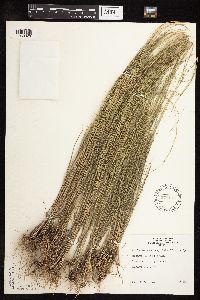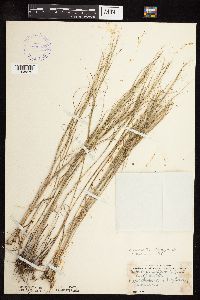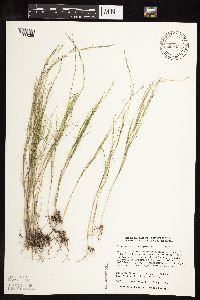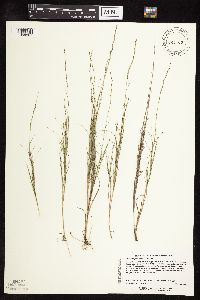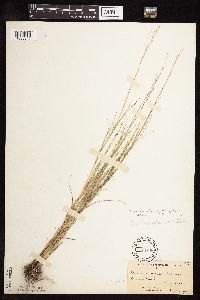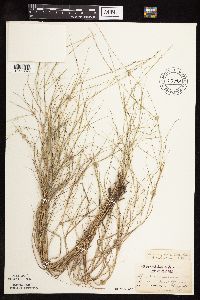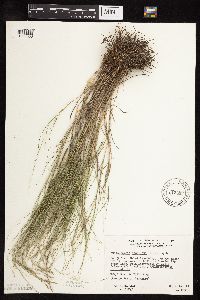Muhlenbergia cuspidata
|
|
|
|
Family: Poaceae
Stony-Hills Muhly, more...Plains Muhly
[Agrostis brevifolia Nutt., moreMuhlenbergia brevifolia Scribn. in Beal, Sporobolus cuspidatus , Vilfa cuspidata] |
Plants perennial; cespitose, with knotty bases, not rhizomatous. Culms 20-60 cm tall, 1-2 mm thick, erect, not rooting at the lower nodes; internodes mostly glabrous or sparsely hispidulous, always hispidulous below the nodes. Sheaths shorter than the internodes, laterally compressed, keeled, smooth or scabridulous, not becoming spirally coiled when old; ligules 0.2-0.8 mm, membranous, truncate; blades 2-22 cm long, 0.5-2.7(3.5) mm wide, flat to folded, smooth or scabridulous abaxially, strigose adaxially. Panicles 4-14 cm long, 0.1-0.8 cm wide, spikelike, not dense; primary branches 0.4-3 cm, appressed; pedicels 0.1-1.2(4) mm. Spikelets 2.5-3.6 mm, dark green or plumbeous, occasionally with 2 florets. Glumes subequal, 1.2-3 mm, about 3/4 as long as the spikelets, 1-veined, gradually acute to acuminate, occasionally mucronate, mucros to 0.3 mm; lemmas 2.5-3.6 mm, lanceolate, sometimes mottled with greenish-black areas, with short, appressed hairs on the basal 1/2-3/4 of the midveins and margins, apices acuminate, sometimes mucronate, mucros to 0.6 mm; paleas 2.4-3.6 mm, lanceolate, glabrous, acuminate; anthers 1.2-1.8 mm, greenish. Caryopses 1.6-2.3 mm, fusiform, brownish. 2n = 20. Muhlenbergia cuspidata grows in dry, gravelly prairies, on gentle rocky slopes, rocky limestone outcrops, and in sandy drainages, at elevations of 300-1400 m, primarily in the central portion of the Flora region. It flowers from June to October. Muhlenbergia cuspidata is often confused with M. richardsonis, but that species has rhizomes and longer ligules. Morden and Hatch (1984) found cleistogamous panicles in the lower sheaths of a plant from Benton County, Oklahoma. Perennial tufted herb with a knotty base 20 cm - 0.74 m tall Leaves: with open sheaths that are shorter than the internodes, laterally compressed, longitudinally folded, smooth to minutely rough, and not spirally coiled with age. The ligules are 0.2 - 0.8 mm long, flat-topped, and membranous, and the blades are 2 - 22 cm long, 0.5 - 3.5 mm wide, flat or folded, smooth or minutely rough beneath, and appressed-hairy above. Inflorescence: terminal, spike-like and branched (panicle), 4 - 14 cm long, 0.1 - 0.8 mm long, with appressed primary branches 0.4 - 3 cm long. Fruit: a brownish, spindle-shaped caryopsis, 1.6 - 2.3 mm long. Culm: 20 cm to 0.6 m long, erect, 1 - 2 mm wide, the internodes bristly-hairy beneath the nodes and mostly hairless or sparsely bristly-hairy elsewhere. Spikelets: borne on a stalk 0.1 - 4 mm long, dark green to lead-colored, 2.5 - 3.6 mm long. Glumes: nearly equal, 1.2 - 3 mm long, gradually tapering to a point, sometimes with an abrupt tip to 0.3 mm long, single-veined. Florets: usually one (sometimes two) per spikelet, with greenish anthers 1.2 - 1.8 mm long. Lemma: sometimes mottled with greenish black spots, 2.5 - 3.6 mm long, lance-shaped and tapering to a pointed tip, occasionally with a short abrupt tip to 0.6 mm long, three-veined, appressed-hairy on the lower one-half to three-fourths of the midveins and margins. Palea: 2.4 - 3.6 mm long, lance-shaped with a pointed tip, two-veined, hairless. Similar species: Muhlenbergia cuspidata is easy to distinguish from other Muhlenbergia species in the Chicago Region. It has awnless spikelets borne on spike-like inflorescences and leaf margins rolling toward the upper surface of the midvein. Flowering: August to October Habitat and ecology: Rare in cracks of bare limestone, shallow prairie soil, and gravelly areas. Occurence in the Chicago region: native Etymology: Muhlenbergia is named after American botanist, Gotthilf Henry Ernest Muhlenberg (1753-1815). Cuspidata means "abruptly short-pointed." Author: The Morton Arboretum Culms tufted, 2-7 dm, slender, stiff and strictly erect, somewhat bulbous-thickened at base or with bulb-like offsets; ligule 0.5 mm or less; blades erect or nearly so, flat or involute, 1-2 mm wide; panicle very slender and spike-like, the appressed lateral branches 5-15 mm; glumes lance-subulate, subequal, 1.7-2.8 mm; lemma 2.8-4.1 mm, slender, acuminate, awnless, minutely pubescent on the back, otherwise glabrous. Prairies and open hillsides, in dry or gravelly soil; Alta. to N.M., e. to Mich., O., Ky., and Mo. Gleason, Henry A. & Cronquist, Arthur J. 1991. Manual of vascular plants of northeastern United States and adjacent Canada. lxxv + 910 pp. ©The New York Botanical Garden. All rights reserved. Used by permission. From Flora of Indiana (1940) by Charles C. Deam This species is infrequent on the high, gravelly bank of the north side of Big Wea Creek where the Shadeland Road crosses the creek about 4 miles southwest of Lafayette. Its associates make it certain that it is a native here. .…… Indiana Coefficient of Conservatism: C = 10 Wetland Indicator Status: N/A |











































